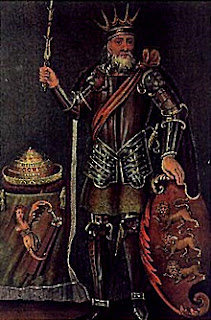King Brian Ború (c. 941 - 1014) Part II
 |
| King Brian Ború |
Following King Brian’s successful capture of Dublin, he reappointed Silkbeard as the city ruler, along with giving his daughter in marriage. Brian had been dissatisfied that his agreement with the High King of Ireland in the year 997 had not been fulfilled. The agreement was to recognise Brian as King of the southern provinces which included Munster and Leinster, allowing for the province of Connaught to follow. He set out to continue his struggle to create a united Ireland. Brian led an army against the High King Máel Sechnaill’s power base in Meath. High King Máel Sechnaill’s closest ally was the King of Connaught, Cathal mac Conchobar mac Taidg, however the river Shannon divided both their Kingdoms. The same river that Brian Ború easily navigated with his naval fleet and this proposed a problem.
Máel Sechnaill built two bridges crossing the river Shannon to allow the armies of Connaught and Meath to cross into each other’s Kingdoms and at the same time hindering Brian’s naval vessels. What happened after this is unclear and the Annals state that in the year 1002 the High King Máel Sechnaill gave his title to Brian. Brian Ború became the High King of Ireland in year 1002.
 |
| O'Brien Family Crest |
In my introduction of Brian Ború I noted that Brian had a vision for a united Ireland. He had wanted Ireland to be a unitary state ruled by one King. The role of High King was not to be a ceremonial role but the overall ruler of the country. Brian at this stage controlled four out of the five provinces in Ireland. The only one remaining was the province of Ulster. A kingdom of formidable kings who controlled all entry points to the province. Brian had a difficult task ahead of him. He used his armies to attack the province from both land and sea. He beat back the Ulster Kings where he could and called on all of his allies for support from within his own provinces. In addition to doing this, Brian used another cunning strategy which involved the church. During this period in Ireland, the Irish Church was centred around monasteries that were headed by powerful abbots. These abbots were members of the royal families of the lands in which their monasteries were based.
One of the most important monasteries at the time was based in Armagh, located within the Ulster Province. In the year 1005 Brian donated an amount of gold to the monastery and declared that Armagh was the religious capital of Ireland and that all other monasteries should send funds that they had collected to it. This was a smart strategy on Brian’s behalf, for Armagh would be held in supremacy over the other monasteries in Ireland as long as Brian was the High King. By the year 1011 all regional kings within Ireland recognised Brian’s authority as the ruler of Ireland. This was short lived for Brian and Máel Mórda, King of Leinster already was planning a rebellion against him.
 |
| Brian Ború Burial Plaque |
Máel Mórda set out to enlist the help of the regional rulers to over throw Brian. Máel Mórda obviously underestimated his ability to gain support or miss judged the loyalty the other leaders had for Brian, even those in Ulster. Máel Mórda turned to his cousin Silkbeard, ruler of Dublin to seek help from overseas. Silkbeard successfully enlisted help from Orkney and the Isle of Man.
Brian may have had armies to outnumber the rebellion with combined forces from Munster, Connaught and Meath, commanded by his old rival Máel Sechnaill. However things turned sour for Brian over a dispute with Máel Sechnaill who withdrew his support just before the arrival of the Norse armies from Orkney and Isle of Man.
1014 AD a mighty and bloody battle took place at Clontarf, north of Dublin City where many nobles lost their lives including Irish Kings, Scotsmen, Norse Gaels, Scandinavians and the last of Ireland’s greatest High Kings. There are many legends of how King Brian Ború actually died, whether he died in hand to hand combat or was over whelmed in his tent by a fleeing group of Vikings after the battle at Clontarf. His tomb lies at St. Patrick’s Cathedral in Armagh City.
Many books and songs have been written about Brian Ború who was one of the greatest High Kings of Ireland who successfully aligned the ruling dynasties of the regional provinces to create a unitary state, even if this was for a very brief time.
The O’Brien dynasty is an Irish royal and noble house descendant from King Brian Ború and the Dalcassians. The O’Brien family continued to rule the province of Munster until the 12th century when their Kingdom was reduced to the Kingdom of Thomand (Co. Clare). Dromoland Castle was to become their royal seat for Thomand. In 1962 Donough O’Brien, 16th Baron Inchiquin sold Dromoland Castle and the O’Brien family moved into Thomand House overlooking the castle where it has become the home of the 18th Baron O’Brien.
King Brian Ború had challenged the ruling system in Ireland that had been in place for over a thousand years and brought about a huge change in governance. Had he been right in wanting to create a unitary state? How different would things have been if he had been successful in holding onto the throne of a united Ireland? Ireland would have been a united nation standing strong against any invader and may not have readily invited foreign kings to its shores!
 |
| Dromoland Castle - Kingdom of Thomand (Co. Clare) |



Comments
Post a Comment